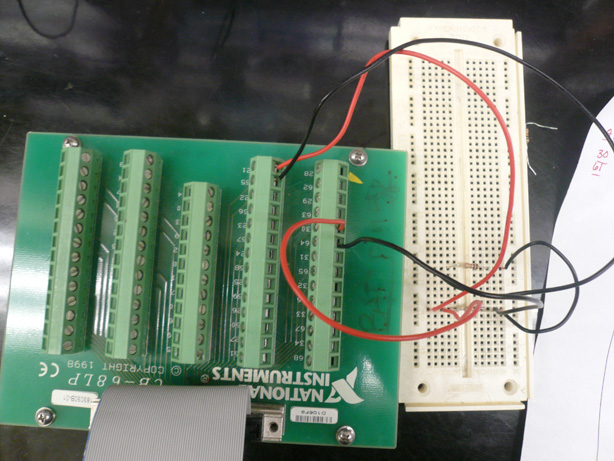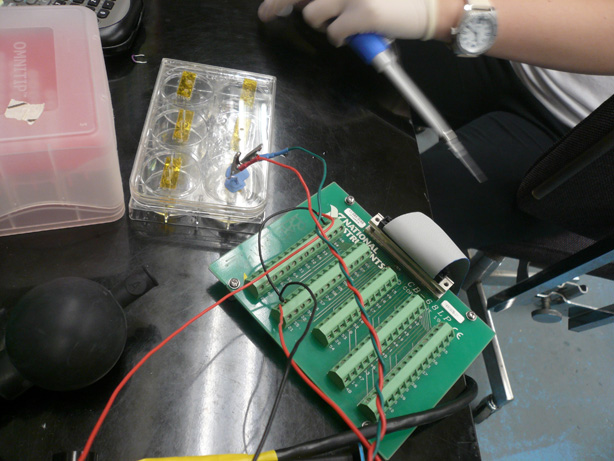Team:Brown/Project/Testing
From 2008.igem.org
| Line 21: | Line 21: | ||
[[Image:Brown daq and cb.jpg|right|thumb|400px|NewApparatus]] | [[Image:Brown daq and cb.jpg|right|thumb|400px|NewApparatus]] | ||
[[Image:Brown daq and mold.jpg|right|thumb|400px|New Apparatus]] | [[Image:Brown daq and mold.jpg|right|thumb|400px|New Apparatus]] | ||
| + | |||
| + | |||
| + | |||
| + | ==The FINAL Apparatus== | ||
| + | * After much work with our resistance apparatus, Team Toxipop made the transition to conductivity measurements with a Vernier Go!Link Conductivity Probe. | ||
| + | |||
| + | You can take readings in units of conductivity (µS/cm) or concentration (mg/L TDS as NaCl). The Conductivity Probe can monitor conductivity at three different sensitivity settings: | ||
| + | |||
| + | * 0-100 mg/L TDS or 0-200 µS/cm | ||
| + | * 0-1000 mg/L TDS or 0-2000 µS/cm | ||
| + | * 0-10000 mg/L TDS or 0-20,000 µS/cm | ||
| + | |||
| + | Conductivity is directly proportional to concentration over the entire range. | ||
| + | |||
| + | The probe has a fast response time, reaching 98% of full value in less than 5 seconds. You can load saved calibrations using any of the Vernier data-collection programs. Alternatively, you can do a quick two-point calibration: the probe is left out of solution for one calibration point (0 µS/cm) and is placed in a known standard (1000 µS/cm solution is provided) for a second calibration point. More precise calibration in two different standards is also possible using our software. | ||
| + | |||
| + | The Conductivity Probe uses alternating current at its electrodes; this prevents polarization and electrolysis, so that solutions being tested are not fouled. Corrosion of metal electrodes is not a problem with this epoxy-body graphite electrode. It has built-in temperature compensation, which allows you to do your calibrations in the lab, and then make measurements outdoors without temperature changes affecting conductivity readings. | ||
| + | -''http://www.vernier.com/probes/con-bta.html'' | ||
Revision as of 04:02, 29 October 2008
|
Resistance
Our First Apparatus
Revisions to the First Apparatus
The FINAL Apparatus
You can take readings in units of conductivity (µS/cm) or concentration (mg/L TDS as NaCl). The Conductivity Probe can monitor conductivity at three different sensitivity settings: * 0-100 mg/L TDS or 0-200 µS/cm * 0-1000 mg/L TDS or 0-2000 µS/cm * 0-10000 mg/L TDS or 0-20,000 µS/cm Conductivity is directly proportional to concentration over the entire range. The probe has a fast response time, reaching 98% of full value in less than 5 seconds. You can load saved calibrations using any of the Vernier data-collection programs. Alternatively, you can do a quick two-point calibration: the probe is left out of solution for one calibration point (0 µS/cm) and is placed in a known standard (1000 µS/cm solution is provided) for a second calibration point. More precise calibration in two different standards is also possible using our software. The Conductivity Probe uses alternating current at its electrodes; this prevents polarization and electrolysis, so that solutions being tested are not fouled. Corrosion of metal electrodes is not a problem with this epoxy-body graphite electrode. It has built-in temperature compensation, which allows you to do your calibrations in the lab, and then make measurements outdoors without temperature changes affecting conductivity readings. -http://www.vernier.com/probes/con-bta.html |
 "
"



